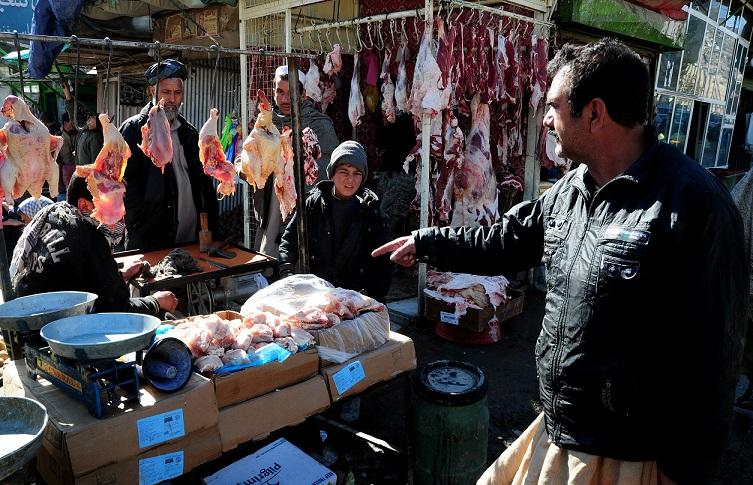KABUL (Pajhwok): Thousands of animals are slaughtered on a daily basis without basic hygiene precautions being taken in central capital Kabul where only ten people are tasked with stopping contaminated meat from reaching the food chain.
A Pajhwok Afghan News survey found that most of butchers in Kabul slaughter animals at homes or shops because only two government abattoirs exist in Kabul City.
One of the two slaughter houses is run by the Ministry of Defense and the second is situated on the outskirts of Kabul City in Kampani area. It is difficult for all butchers to take their animals to the two places.
At the slaughter house in Kampani, there was no equipment to test hygiene. This situation contributes to the city’s environmental pollution and poses a threat to consumer health.
Slaughtering animals without safety checks
Dr. Mohammad Edrees Tokhi, Kabul Municipality’s Environmental Safety director, told Pajhwok Afghan News almost 4,000 animals, including cows, sheep and cattle were daily slaughtered in Afghanistan.
“For health reasons, every animal should be examined by a veterinary physician before it is slaughtered, but in Afghanistan this trend is yet to be introduced.”
Referring to the lack of slaughter houses, Tokhi said in their absence it was difficult to control how animals were slaughtered and to check if basic hygiene precautions were considered.
He said no equipment to test hygiene precautions before slaughtering animals was available at the Kampany slaughter house.
But Mohammad Saleem Sardar, head of butchers at Shahr-i-Naw’s butcher street, said the long distance to Kampany area forced butchers to slay animals at their homes.
“Every butcher slaughters animals at home and transfers the waste to Khaikhana Kotal where they are used as agriculture input. We skin animals at our shops.”
The government has not provided butchers any facility to make sure the meant is safe to eat, but Sardar say butchers based on their experience could differentiate between a health and a sick animal.
Checking meat after slaughtering
Dr. Khalil Niyazi, director of livestock products control at the Agriculture Ministry, said: “The right things is to check animal before slaughtering, but due to a lack of this facility, we check meat at shops.”
He said animal if not properly slaughtered its meat contained blood and had a changed color and some butchers entered water through one of the arteries.
He added meat having no blood, water and maintained color was approved for sale by his department.
Controlling 2,000 slaughter shops only by 10 persons
Niazai said only six personnel could not manage or control more than 2,000 slaughter shops in 22 police districts of Kabul City.
He said lack of slaughterhouses had a negative impact on their performance. “If slaughter shops in the city are few, they could be easily controlled and their meat checked.”
Dr. Jahangir Miakhel, livestock and animals health general director at the Ministry of Agriculture, Livestock and Irrigation (MALI), said that there were 13 workers in his department.
He said due to their limited number, his department workers could not handle all slaughter shops in the city. The number of personnel in the department would be increased in future, he said.
Environmental health section head at Kabul municipality also said that the lack of standard slaughterhouses and personnel had made it hard to check meat at all slaughter shops in Kabul city.
In Kabul, health stamped meat could be seen only in a few slaughter shops.
A butcher in Taimani area of Kabul, who wished to go unnamed, said, “A year back, a doctor from the ministry of agriculture would stamp meat in my shop every day, but I could not see him since one year and the meat is no longer stamped.”
Spread of diseases
As livestock are slaughtered and their meat sold in market without being tested, Mohammad Tokhi, a doctor, said that 800 types of diseases could be transferred from animal products to humans.
He said Toxoplasmosis, Brucellosis, Influneza and Crimean Congo Haemorrhagic Fever (CCHF) diseases were most common being transferred from animal products to humans.
Dr. Abdur Rahman Akbari, head of Kabul Antani Hospital, said that Brucellosis, CCHF, (Anthrax ،Charbon) and Zoonoses diseases were registered in the hospital.
According to a report, Shah Wali Marofi, head of controlling communicable diseases in the Ministry of Public Health, in October last year said that CCHF alone killed 28 people in Kabul in one year.
Solution
Environmental health section head at the Kabul municipality, said that the Ministry of Agriculture should build at least four more slaughterhouses in Kabul for preventing diseases and environment pollution.
The proposed slaughterhouses should be standard and their meat should be checked for health as well as to be accessible in four corners of Kabul, he said.
Dr. Jahangir Miakhel, general director of livestock and animals health at MAIL, said that work on two slaughterhouses was underway in Rishkor area and Karizmir area of Kabul and they would be ready in six months.
He said the slaughterhouses would be equipped with advanced tools. No one would be allowed to open a slaughter shop or arbitrary slaughter centers the areas after the two slaughterhouses were activated, he said.
Kabul municipality’s environmental health official said they would also prepare a procedure for all butchers to help protect sanitation and environment.
Many slaughter shops that violated municipality rules in Deh Afghanan area of Kabul had been closed down, he said.
ma








GET IN TOUCH
NEWSLETTER
SUGGEST A STORY
PAJHWOK MOBILE APP